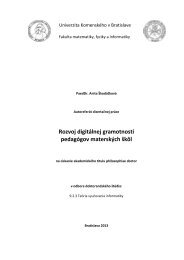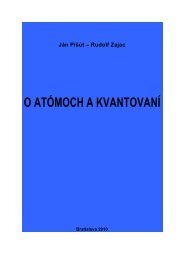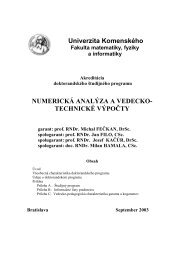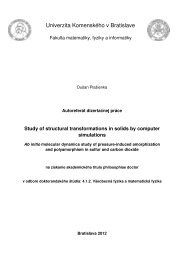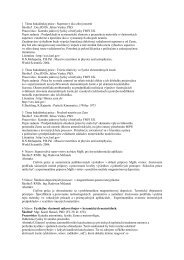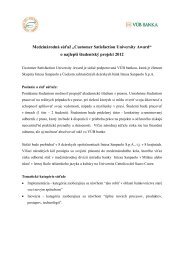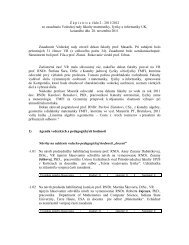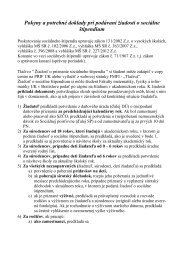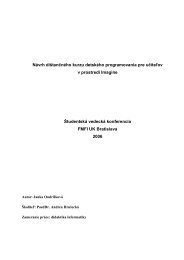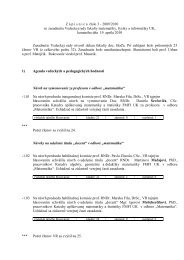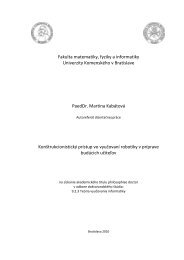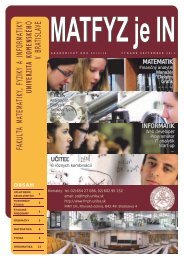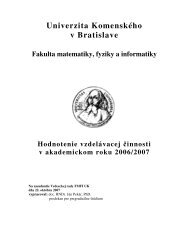Autoreferát - Fakulta matematiky, fyziky a informatiky - Univerzita ...
Autoreferát - Fakulta matematiky, fyziky a informatiky - Univerzita ...
Autoreferát - Fakulta matematiky, fyziky a informatiky - Univerzita ...
You also want an ePaper? Increase the reach of your titles
YUMPU automatically turns print PDFs into web optimized ePapers that Google loves.
<strong>Univerzita</strong> Komenského v Bratislave<strong>Fakulta</strong> <strong>matematiky</strong>, <strong>fyziky</strong> a <strong>informatiky</strong>RNDr. Peter Schlosser<strong>Autoreferát</strong> dizertačnej práceChemical sensors based on TiO2 thin filmsna získanie akademického titulu philosophiae doctorv odbore doktorandského štúdia: 4.1.3 Fyzika kondenzovaných látok a akustikaBratislava,2012
Dizertačná práca bola vypracovaná v externej forme doktorandského štúdia na Katedre experimentálnej <strong>fyziky</strong>Univerzity Komenského v Bratislave.Predkladateľ:RNDr. Peter SchlosserKatedra experimentálnej <strong>fyziky</strong>, FMFI UKMlynská dolina F2, 842 48 BratislavaŠkoliteľ:Doc. RNDr. Michal Maheľ CSc.Katedra experimentálnej <strong>fyziky</strong>, FMFI UKMlynská dolina F2, 842 48 BratislavaOponenti:Obhajoba dizertačnej práce sa koná dňa ..................... o ............. hod. pred komisiou pre obhajobu dizertačnejpráce v odbore doktorandského štúdia 4.1.3 Fyzika kondenzovaných látok a akustika vymenovanou predsedomodborovej komisie dňa: ........................................Miesto konania:zasadačka ...............................<strong>Fakulta</strong> <strong>matematiky</strong>, <strong>fyziky</strong> a <strong>informatiky</strong> Univerzity KomenskéhoMlynská dolina F2, 842 48 Bratislava..........................................................................Prof. RNDr. Peter Kúš, DrSc.predseda komisieKatedra experimentálnej <strong>fyziky</strong>, FMFI UKMlynská dolina F2, 842 48 Bratislava
Chemical sensors based on TiO 2 thin filmsPeter SchlosserSupervisor: Assoc. Prof. Michal MaheľDepartment of Experimental Physics, Faculty of Mathematics, Physics and Informatics,Comenius University in BratislavaJune 2012In the past few decades chemical sensors based on Metal Oxide Semiconductors have beenattracting the attention of many scientists and engineers due to their simple operation, cheappreparation cost and wide applicability. The demand for these chemical sensors has been growingcontinuously due to the emergence of new possible applications in a variety of industries. The field ofgas sensors can particularly benefit from the recent developments in the hydrogen fuel cell industry.Along with the renewable resources, hydrogen has been considered one of the potential clean sourcesof energy which can eventually replace the depleting fossil fuels. As opposed to the renewableresources, hydrogen is a fuel which can be stored. Therefore its chemical energy can be transformed toelectrical energy at any given time, which eliminates the need for accumulators. However the biggestdisadvantage of using hydrogen is that it is extremely combustible. Therefore as its range ofapplication grows, a demand for cheap, reliable, selective sensors which are capable of the quickdetection of hydrogen leaks grows as well.In this project we report the preparation of gas sensors based on TiO 2 thin films. The thin filmswere deposited on single crystal sapphire substrates (c-cut and r-cut) using the reactive DC magnetronsputtering technique. In the first part of the project, the influence of the partial pressure of oxygen andthe temperature of the post deposition annealing on various properties of the thin films wasinvestigated. Subsequently platinum electrodes were prepared on top of these films and their electricalresponses to various concentrations of H 2 were measured. The effect of the phase composition and themicrostructure on the gas sensing properties of the films is analyzed and discussed. We found that insome cases (especially in samples prepared at low partial pressure of oxygen) the thin films exhibitedan electrical response, which could be interpreted with the formation of mixed phases with differenttypes of conductivities. This resulted in a decreased sensitivity especially at lower temperatures. Wealso found that the films deposited on c-cut substrates had a nanostructured, granular character whilethe films deposited on r-cut substrates exhibited dense epitaxial character. In spite of the completelydifferent microstructures, both of these types of films had very high sensitivities (up to 10 6 ) to H 2 . Theuncertainty of the origin of these high sensitivities prompted the Current-Voltage measurements ofsome selected samples.In the second part of this project the theoretical modelling of the DC IVcharacteristics of sensorstructures is presented. The geometry and the parameters applied in this modelling were selected to
closely resemble the geometry and the parameters of the real sensor structures prepared in this project.The theoretical results were compared with the experimental IV characteristics of some selectedsamples. Based on these results we evaluated the possible causes of the high sensitivities.
AbstraktChemické senzory na báze TiO 2 tenkých vrstievRNDr. Peter SchlosserŠkoliteľ: Doc. RNDr. Michal Maheľ CSc.Katedra experimentálnej <strong>fyziky</strong>, <strong>Fakulta</strong> <strong>matematiky</strong>, <strong>fyziky</strong> a <strong>informatiky</strong>Univerzity Komenského v BratislaveJún 2012Chemické senzory na báze polovodivých oxidov kovov už niekoľko desaťročí priťahujúpozornosť mnohých vedcov, a to najmä pre ich nízke prípravné náklady, široké možnosti použitiaa jednoduché ovládanie.Dopyt po týchto chemických senzoroch neustále rastie kvôli vzniku novýchmožných aplikácií v rôznych priemyselných odvetviach. Najnovší vývoj v oblasti vodíkovýchpalivových článkov môže priniesť dalšie nové možnosti využitia plynových senzorov. Obnovitelnézdroje a vodík sú považované za čisté zdroje energie, ktoré môžu v budúcnosti potenciálne nahradiťfosílne palivá. Na rozdiel od obnoviteľných zdrojov, vodík je palivo, ktoré sa dá zásobovať a jehochemická energia sa tak dá použiť v ľubovolnom okamihu. Lenže najväčšu nevýhodu vodíkapredstavuje jeho extrémna výbušnosť. Z tohto dôvodu s rozširovaním uplatnenia vodíka rastie ajdopyt po lacných, spoľahlivých a selektívnych senzoroch, ktoré dokážu rýchlo detekovať únik tohtoplynu.V tomto projekte opisujeme prípravu plynových senzorov na báze tenkých vrstiev TiO 2 . Tenkévrstvy boli deponované na zafírove substráty (orientáciou c-cut a r-cut) s metódou reaktívneho DCmagnetrónového naprašovania. V prvej časti projektu sme skúmali vplyv parciálneho tlaku kyslíkaa teploty žíhania na rôzne vlastnosti tenkých vrstiev. Následne na povrchu týchto vrstiev smepripravili platinové elektródy, a merali sme ich elektrické odozvy na rôzne koncentrácie vodíka.Sledovali sme vplyv mikroštruktúry a fázového zloženia vrstiev na ich detekčné vlastnosti. Zistili sme,že v niektorých prípadoch (hlavne pri nižších parciálnych tlakoch kyslíka) vo vrstvách vznikajúzmiešané fázy s rôznymi typmi vodivosťami, ktoré znižujú citlivosť týchto vrstiev hlavne pri nižsíchteplotách. Ďalej sme spozorovali, že vrstvy pripravené na c-cut substrátoch mali zrnitý, nanoštruktúrnycharakter, zatiaľ čo vrstvy deponované na r-cut substrátoch vykazovali epitaxiálny charakter. Napriekzjavne rozdielnym mikroštruktúram, oba tieto typy filmov vykazovali veľmi vysokú citlivosť na
vodík (pri 10000 ppm až 10 6 ). Z dôvodu skúmania pôvodu tejto vysokej citlivosti sme tieto vzorkypodrobili meraniu IV charakteristík pri rôznych koncentráciach vodíka.V druhej časti tejto práci sme sa zaoberali teoretickým modelovaním IVcharakteristík senzorických štruktúr. Geometria a parametre použité v tomto modelovaní boli zvolenétak, aby sa čo najviac podobali na reálne senzory ktoré sme pripravili v rámci tohto projektu.Vypočítané IV charakteristiky sme porovnali experimentálnymi IV charakteristikami niektorýchvybraných vzoriek. Na základe týchto poznatkov sme vyhodnotili možné príčiny vysokých citlivostítýchto vzoriek.
1 IntroductionGas sensors based on metal oxide semiconductors belong to the group of direct chemicalsensors which convert the chemical state (concentration, partial pressure) of an analyte intomeasurable electrical signal. The relation between the electrical conductance of the sensor andthe concentration of the analyzed gas can be expressed with the following empirical formula:Where G 0 is the conductance of the sensor in the absence of the analyzed gas, [C] is theconcentration of the analyzed gas and A and m are constants which are characteristic for thecombination of the material and the analyzed gas. In spite of this simple empirical formula,the electrical signal of a sensor is influenced by variety of factors. As shown on the simplifiedillustrative Figure 1.1 the current passing through the sensor can be influenced by the bulk ofthe grain, grain boundary, as well as the electrode interface. In fact all these elements can beo - o - o -o -o - o - o - o -- o - o - o - o - o - o - o -o -o -- o - o - o -o -o - o -o -o - o -o -o - o - o -o - o -o -o - o-o - o - o - o - o-o -o - o - o - o - o - o - o -o - o - o- o -o - o - o - o - o- o- oo - o --o - o -2H + eV SeV SBH H 2O+ -U TA.Figure 1.1 Illustrative figure of the working mechanism of a gas sensor based on MOS
sensitive to the change of the partial pressure of the analyte gas. Generally the sensingmechanism of the MOS gas sensors is based on the adsorption of gases on the surfaces of thegrains [1]. In this case the sensitivity of the films strongly depend on the variety of factors likethe density of donors, density of surface sites available for adsorbtion or the microstructure ofthe film. The bulk can also be sensitive to changes of the concentration of the analyte gas. Forexample in case of TiO 2 at high temperatures the change in the partial pressure of oxygeninduces a change in the oxygen vacancies which in turn results in a change of the bulkconductivity [2]. The metal electrodes can also play an important role in the gas sensing. TheSchottky barrier created at the MS interface can be sensitive to changes in the concentrationof the analyte gas [3] [4]. In different cases different elements can dominate the gas sensingmechanism. These effects can even superimpose on each other. The motivation of this studywas to better understand the role of these individual elements of the sensor structure in the gassensing as well as to investigate the influence of the microstructure on the sensitivities of thethin films prepared by DC magnetron sputtering. The theses of this works are listed below:The preparation of high quality TiO 2 thin films using reactive DC magnetron sputteringInvestigation of the influence of the partial pressure of oxygen (during deposition process)and the temperature of the post deposition annealing on various properties of the thinfilmsDevelopment of an experimental method for the investigation of the gas sensingproperties of the chemical sensorsThe investigation of the electrical and the gas sensing properties of the prepared chemicalsensorsTheoretical modelling of the DC current-voltage characteristics of sensor structuresComparing the results of theoretical modeling with the measured current-voltagecharacteristics of the prepared sensors
2 Experimental partThe TiO 2 thin films were deposited on single crystal sapphire substrates (c-cut and r-cut)using reactive DC magnetron sputtering technique. An unbalanced magnetron with a metallictitanium target (purity 99.9%) was used for the deposition. During the deposition, the partialpressure of the oxygen was monitored by a built-in mass spectrometer which gave feedbackto the control system. This control system adjusted the gas dosing valves accordingly to keepthe partial pressure of the oxygen in the chamber constant and the sputtering process stable.The deposited samples were subsequently annealed for 1 hour in a tube furnaceThe various properties of the thin films were investigated by experimental methodslike XRD, AES, AFM, UV-VIS, TEM. After these analyses interdigital transducer shapedmeasurement electrodes were prepared on top of the thin films (See Figure 2.1). Opticallithography was used to fabricate the comb-like patterns and subsequently Pt was depositedby DC magnetron sputtering technique.Figure 2.1 Optical microscope image (left) and the dimension diagram (right) of theinterdigital transducers (dimension units in micrometers)Computer controlled gas test system (Figure 2.2) had been designed and built tocharacterize the gas sensing performance of the prepared thin films. The gas mixing in thissystem is carried out with two thermal mass flow controllers, which control the flow rate ofthe test gas (1% Hydrogen in dry synthetic air) and the carrier gas (dry synthetic air). Therange of Hydrogen concentration which can be achieved in this setup is from 60 to 10000ppm. The measurement chamber contains a ceramic heater with an electrical contactingplatform which holds the sample during the measurement. Electrical characterization is done
with the help of Keithley 6487 Picoammeter/Voltage Source, which enables us to measureresistances up to 100 GOhms. The measurement is executed by a program written in Matlabwhich supports Current-Voltage, Resistance vs. Temperature and Resistance vs. timemeasurements in different gas concentrations.Figure 2.2 Schematic diagram of the gas test apparatus.
3 ResultsThe main goal of this project has been the preparation and characterization ofchemiresistive gas sensors based on TiO 2 thin films. In the first part of the project weinvestigated the influence of the partial pressure of oxygen during the deposition process andthe effect of the post-deposition annealing temperature on the structural, morphological,optical, electrical and gas sensing properties of the prepared thin films. For this purpose twoseries of samples had been prepared. In both series the layers were deposited on a c-cut singlecrystal sapphire substrate. The pressure series consisted of samples deposited at differentpartial pressures of Oxygen spanning from 0.028 to 0.12 Pa and the temperature seriesconsisted of samples annealed at different temperatures from 600ºC to 1000ºC in 100ºCincrements. All other deposition parameters were kept constant within each series.Figure 3.1 Temperature dependence of the gas sensivity (10000 ppm of H2) of thesamples of the pressure seriesWe found that by changing value of the partial pressure of oxygen the phasecomposition of the prepared thin films can be altered. We also found that the oxygen pressurehad a great influence on the gas sensing properties of the films. Some samples (especially theones prepared at low partial pressure of oxygen) exhibited an electrical response, which couldbe interpreted with the formation of mixed phases with different types of conductivities. Thisresulted in a decreased sensitivity of these samples especially at lower temperatures (See rightside of Figure 3.1.)
The annealing temperature greatly influenced the microstructure of the prepared films.The lateral sizes of the grains increased with the increasing annealing temperature. Thegrowth of the vertical size was limited by the small thickness of the film. The sensitivity ofthe films seemed to decrease with the increasing annealing temperature up to 800ºC. Weattributed this decrease to the decreasing potential barrier height which is probably caused bythe lower densities of donors. The sensitivity increased again for the sample annealed at900ºC, this however could have been the result of the different phase, as this thin filmcontained only rutile.Figure 3.2 The sensitivity plots and the temperature dependence of the gas sensivity(10000 ppm of H2) of the samples of the temperature seriesThin films were also deposited on the r-cut sapphire substrate to study the effect of theorientation of the substrate. The microstructures of these films had an epitaxial character. Ascompared to the nanostructured granular character of the thin films prepared on c-cutsapphire, these films contained large flat grains with lateral sizes up to couple micrometers(Figure 3.3). The electrical and gas sensing measurements revealed surprisingly largesensitivities of these films towards H 2 gas (Figure 3.4). The values of the sensitivities at10000 ppm reached 10 6 despite the low surface to volume ratio of these films. The unknownorigin of this high sensitivity prompted the comparative study presented in the second part ofthe project.
Figure 3.3 AFM images of samples D32 (c-cut) and D16 (r-cut)Figure 3.4 Sensitivity plots of samples D11 (left) and D16 (right) at differenttemperaturesIn the second part of the project the theoretical modelling of the DC current-voltagecharatceristics of real sensoric structures is shown. We have used a modified version of the1D method applied by Varpula [5] which assumes that the film consists of a single row ofidentical grains with identical parameters of the bulk and the grain boundaries. In order tostudy the effect of the electrical contacts on the sensor signal we have extended this model byadding metal contacts to the first and the last grain. The formation of identical Schottkybarriers at both MS interfaces was assumed. The illustrative figure of the modeled sensorstructure is shown on Figure 3.5. The motivation of this study was to better understand theinfluence of the individual elements of the sensor on the overall electric signal. The geometry
and the parameters applied in this modelling were selected to closely resemble the geometryand the parameters of the real sensor structures prepared in this project. The theoreticalresults were compared with the actual measured current-voltage characteristics of twosamples D16 (r-cut) and D32 (c-cut). These two samples were selected due to theircompletely different microstructures. The AFM and TEM studies revealed that while sampleD16 was practically epitaxial with very large flat grains (lateral sizes up to couplemicrometers), sample D32 had a nanostructured, granular character (lateral grain sizes around60 nm). However despite of the completely different microstructures, the electrical responsesof the thin films to Hydrogen were very similar. Both samples exhibited sensitivities up to 10 6to 10000 ppm of H 2 .d elx fSB2x d0x bulkqUx fSBqU bSBqU gbulkqU GBqU GBqU fSBqU gbulkForward SB1st GBn-th GBBackward SBUAFigure 3.5 Illustrative figure of the modeled sensoric structure
Figure 3.6 Logarithmic plot of the IV data of samples D16 and D32 at differentconcentrations of H2 in syntheticFigure 3.7 The influence of VS on the IV characteristics of the sensor structure for n=3(on left) and n=50 (on right)Based on this comparative study we have concluded that in case of the granularnanostructured thin films, the current is governed by the grain boundaries of the film. Thehigh sensitivity of these samples is therefore given by the gas induced change in the amountof chemisorbed species on the surface of the grains. In case of the films with the epitaxialcharacter the the super-linear character of the IV curves in the absence of the reducing gascould be caused by the MS interface as well as by the small amount of GB barriers. Todefinitely identify the origin of the high sensitivities of these samples, IV measurementswould have to be conducted on samples where one of the contacts is ohmic. We think,however, that it is reasonable to believe that both GB and MS interface can dominate the IVcurve at different values of applied voltages depending on the operation temperature andconcentration of the analyte gas. Therefore both of these mechanisms play a role in the overallgas sensitivity of these types of samples.
4 Bibliography[1] M. Bögner, T. Doll. Advanced gas sensing - The electroadsorptive effect and relatedtechniques. [ed.] T. Doll. s.l. : Kluwer Academic Publishers, 2003, Chapter1: Introduction tothe electroadsorptive effect and its applications, p. 1-39.[2] Zakrzewska, K. Titanium Dioxide thin films for Gas Sensors and Photonic Applications.s.l. : Wydawnictwa AGH, Krakow, 2003.[3] K. D. Schierbaum, U. K. Kirner, J. F. Geiger and W. Göpel. 1991, Sensors andActuators B, Vol. 4, p. 87-94.[4] T. Iwanaga, T. Hyodo, Y. Shimizu, M. Egashira. 2003, Sensors and Actuators B , Vol.93, p. 519–525.[5] Varpula, A. Modelling of electrical properties of granular semiconductors. HELSINKIUNIVERSITY OF TECHNOLOGY. 2009.List of publicationsADC Scientific papers in foreign CC journalADC01 Haidry, Azhar Ali 15% - Schlosser, Peter 10% - Ďurina, Pavol 10% - Mikula, Marián 10% - Tomášek,Milan 10% - Plecenik, Tomáš 10% - Roch, Tomáš 5% - Pidík, Andrej 5% - Štefečka, Miloslav 5% -Noskovič, Jaroslav 5% - Zahoran, Miroslav 5% - Kúš, Peter5% - Plecenik, Andrej 5%: Hydrogen gassensors based on nanocrystalline TiO(2) thin filmsLit. 19 zázn.In: Central European Journal of Physics. - Vol. 9, No. 5 (2011), s. 1351-1356AFD Published contributions at national scientific conferencesAFD01 Schlosser, Peter - Maheľ, Michal - Kúš, Peter - Plecenik, Andrej : Meranie AC magnetickejsusceptibility supravodivých materiálovLit. 6 zázn.In: Moderné trendy vo fyzike plazmy a tuhých látok. - Bratislava : [FMFI UK], 2006. - S. 203-207. - ISBN80-89186-09-2[Moderné trendy vo fyzike plazmy a tuhých látok. Bratislava, 27.10.2005]AFD02 Schlosser, Peter 40 % - Jacko, Vladimír 40 % - Plecenik, Andrej 20 %: Príprava tenkých vrstiev VOxpre využitie v mikrobolometroch
In: The 3rd Seminar on New Trends in Plasma Physics and Solid State Physics. - Bratislava : Knižničné aedičné centrum FMFI UK, 2007. - S. 138-140. - ISBN 978-80-89186-24-2[Seminar on New Trends in Plasma Physics and Solid State Physics 2007. 3rd, Bratislava, 4.10.2007]AFD03 Hartmanová, Mária - Kubel, F. - Schneider, J. - Jergel, M. - Kundracik, František 16,5 % - Schlosser,Peter 16,5 %: Crystal structure and type of ZrO2 - M2O3 (M = Yb, Y, Sm) solid solutionsLit. 11 zázn.In: 14th International Conference on Applied Physics of Condensed Matter : Proceedings. - Bratislava :Slovenská technická univerzita, 2008. - S. 82-87. - ISBN 978-80-227-2902-4[APCOM 2008 : Applied Physics of Condensed Matter : International Conference. 14th, Liptovský Ján-Bystrá, 25.-27.6.2008]AFD04 Schlosser, Peter 12,5 % - Vargová, M. - Kubinec, Milan 12,5 % - Haščík, Š. - Roch, Tomáš 12,5 % -Plecenik, Andrej 12,5 % - Plesch, Gustáv 12,5 % - Hotový, I. : Preparation of micromachined gas sensoron thin membranesLit. 6 zázn.In: 14th International Conference on Applied Physics of Condensed Matter : Proceedings. - Bratislava :Slovenská technická univerzita, 2008. - S. 199-202. - ISBN 978-80-227-2902-4[APCOM 2008 : Applied Physics of Condensed Matter : International Conference. 14th, Liptovský Ján-Bystrá, 25.-27.6.2008]AFD05 Hartmanová, Mária - Jergel, M. - Holgado, Juan Pablo - Kundracik, František 20% - Schlosser, Peter20%: Surface and cross-sectional microstructure/morphologies of CeO2-Sm2O3 filmsLit. 4 zázn., 7 obr., 1 tab.In: 15th International Conference on Applied Physics of Condensed Matter. - Žilina : University of Žilina,2009. - S. 113-116. - ISBN 978-80-554-0057-0[APCOM 2009 : Applied Physics of Condensed Matter : International Conference. 15th, Liptovský Ján-Bystrá, 24.-26.6.2009]AFD06 Jacko, Vladimír - Schlosser, Peter 20% - Roch, Tomáš 15% - Zahoran, Miroslav 10% - Kúš, Peter 10% -Plecenik, Andrej 10%: Thin-layer bolometric structures [elektronický dokument]7 obr.In: 17th Conference of Slovak Physicists Proceedings (CD ROM). - Bratislava : Slovak Physical Society,2009. - S. 137-138. - ISBN 978-80-969124-7-6[Konferencia slovenských fyzikov 2009. 17., Bratislava, 16.-19.9.2009]AFG Abstracts from international conferencesAFG01 Jesenák, Karol - Schlosser, Peter - Kozlovská, B. - Plecenik, Tomáš - Plesch, Gustáv - Plecenik, Andrej -Kúš, Peter : TiO2 films for sensoric structures prepared by sol-gel methodsLit. 2 zázn.In: Solid State Chemistry 2006. - Pardubice : University of Pardubice, 2006. - S. 199[SSC 2006 : Solid State Chemistry : International Conference. 7th, Pardubice, 24.-29.9.2006]AFH Abstracts from national conferencesAFH01 Kozlovská, Božena - Schlosser, Peter - Plecenik, Tomáš - Gregor, Maroš - Čaplovičová, Mária -Jesenák, Karol - Kuchta, Ľubomír - Kúš, Peter - Plecenik, Andrej - Plesch, Gustáv : The influence ofpreparation conditions on the properties oftitanium dioxide thin films for sensors prepared by sol-geltechniqueIn: 5th Solid State Surfaces and Interfaces. - Bratislava : Institute of Physics SAS, 2006. - S. 59[SSSI 2006 : Solid State Surfaces and Interfaces : Conference. 5th, Smolenice, 19.-24.11.2006]AFH02 Kundracik, František 17% - Hartmanová, Mária - Lomonova, Elena E. - Kubel, F. - Holgado, Juan Pablo- Schlosser, Peter 5%: Dielectric properties of YbxZr1-xO2-x/2 solid solutionsLit. 3 zázn., 1 tab.In: 8th Conference on Solid State Chemistry: Book of Abstracts. - Bratislava : Slovac Academy ofSciences, 2008. - S. 139. - ISBN 978-80-224-1019-9[SCC 2008 : Solid State Chemistry. 8th, Bratislava, 6.-11.7.2008]
AFH03 Haidry, Azhar Ali 9% - Schlosser, Peter 7% - Mikula, Marián 7% - Ďurina, Pavol 7% - Noskovič,Jaroslav 7% - Plecenik, Tomáš 7% - Husanikova, Petra 7% - Roch, Tomáš 7% - Vargová, Melinda 7% -Plesch, Gustáv 7% - Pidík, Andrej 7% - Zahoran, Miroslav7% - Plecenik, Andrej 7% - Kúš, Peter 7%:Comparative study of hydrogen gas sensors based on TiO2 thin films prepared by sol-gel method andreactive magnetron sputteringLit.: 4 zázn., 2 obr.In: WODiM 2010. 16th Workshop on Dielectrics in Microelectronics. - Bratislava : IEE SAS, 2010. - S.138[Dielectrics in Microelectronics 2010 : Workshop. 16th, Bratislava, 28.-30.6.2010]AFK Poster presentations at international conferencesAFK01 Schlosser, Peter 30% - Jacko, Vladimír - Roch, Tomáš 10% - Haščík, Štefan - Zahoran, Miroslav 10% -Plecenik, Andrej 10%: Preparation of VOx thin films by DC magnetron sputtering for bolometricapplicationsIn: JVC-12 / EVC-10 / AMDVG-7 Programme and Book of Abstracts. - Budapest : REPS, 2008. - S. 134[JVC 2008 : Joint Vacuum Conference. 12th, Balatonalmádi, 22.-26.9.2008][EVC 2008 : European Vacuum Conference. 10th, Balatonalmádi, 22.-26.9.2008][AMDVG 2008 : Annual Meeting of the German Vacuum Society. 7th, Balatonalmádi, 22.-26.9.2008]AFK02 Kundracik, František 16% - Hartmanová, Mária - Lomonova, Elena E. - Kubel, Frank - Holgado, JuanPedro - Schlosser, Peter 16%: Dielectric properties of ZrO2-Yb2O3 solid solutionsIn: International Conference on Materials for Advanced Technologies ICMAT 2011. - Singapore :Materials Research Society, 2011. - S. 101[ICMAT 2011 : International Conference on Materials for Advanced Technologies. Singapore, 26.6.-1.7.2011]AFL Poster presentations at national conferencesAFL01 Schlosser, Peter 30% - Vargová, Melinda 18% - Roch, Tomáš 20% - Plecenik, Tomáš 5% - Maheľ,Michal 5% - Plesch, Gustáv 17% - Plecenik, Andrej 5%: Gas sensitive TiO2 thin films prepared onsubstrates treated with high-pressure atmospheric plasmaIn: 8th Conference on Solid State Chemistry. - Bratislava : SAS, 2008. - S. 263[SSC 2008 : Solid State Chemistry : International Conference. 8th, Bratislava, 6.-11.7.2008]EDJ Reviews, professional translations in journals and proceedingsEDJ01 Plecenik, Andrej - Gregor, Maroš - Kúš, Peter - Mičunek, Radovan - Plecenik, Tomáš - Zahoran,Miroslav - Schlosser, Peter - Tomášek, Milan - Gašparík, Vladimír : Tenké vrstvy a tenkovrstvovénanoštruktúry pre kryoelektroniku a senzorikuLit. 2 zázn., 2 obr.In: Československý časopis pro fyziku. - Sv. 55, č. 6 (2005), s. 505EDJ02 Plecenik, Andrej - Bezák, Viktor - Gašparík, Vladimír - Grajcar, Miroslav - Grančič, Branislav - Greguš,Ján - Hlubina, Richard - Maheľ, Michal - Mičunek, Radovan - Kúš, Peter - Plecenik, Tomáš - Schlosser,Peter - Tomášek, Milan - Zahoran, Miroslav : Hlavné vedecké aktivity na oddelení Fyziky tuhých látok,Katedra experimentálnej <strong>fyziky</strong> FMFI UK v Bratislave [elektronický dokument]In: Moderné trendy vo fyzike plazmy a tuhých látok (CD ROM). - Bratislava : [FMFI UK], 2006. - S. 43-81. - ISBN 80-89186-09-2[Moderné trendy vo fyzike plazmy a tuhých látok. Bratislava, 27.10.2005]GAI Research studies and interim reportsGAI01 - Schlosser, Peter 16% - Jacko, Vlado - Kubinec, Milan 14% - Haščík, Štefan - Roch, Tomáš 14% -Zahoran, Miroslav 14% - Plecenik, Andrej 14%: Príprava tenkých vrstiev VOx na visiacich membránach9 obr.In: 2. Zborník príspevkov štipendistov z projektu JPD 3 BA 2005/1-043. - Bratislava : Knižničné a edičnécentrum FMFI UK, 2008. - S. 95-98. - ISBN 978-80-89186-26-6Priebežná správa,



